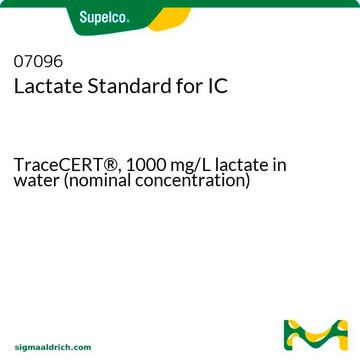1356734
USP
Lactic acid
United States Pharmacopeia (USP) Reference Standard
Synonym(s):
DL-Lactic acid, 2-Hydroxypropionic acid
About This Item
Recommended Products
grade
pharmaceutical primary standard
API family
lactic acid
Assay
89.1% (lactic acid basis)
manufacturer/tradename
USP
technique(s)
HPLC: suitable
refractive index
n20/D 1.425 (lit.)
bp
122 °C/15 mmHg (lit.)
density
1.209 g/mL at 25 °C (lit.)
application(s)
pharmaceutical (small molecule)
format
neat
storage temp.
2-8°C
SMILES string
CC(O)C(O)=O
InChI
1S/C3H6O3/c1-2(4)3(5)6/h2,4H,1H3,(H,5,6)
InChI key
JVTAAEKCZFNVCJ-UHFFFAOYSA-N
Looking for similar products? Visit Product Comparison Guide
General description
Application
Also, for use with USP monographs such as:
- Fumaric Acid
- Maleic Acid
Analysis Note
Other Notes
related product
Signal Word
Danger
Hazard Statements
Precautionary Statements
Hazard Classifications
Eye Dam. 1 - Skin Corr. 1C
Supplementary Hazards
Storage Class Code
8A - Combustible corrosive hazardous materials
WGK
WGK 1
Flash Point(F)
235.4 °F - closed cup
Flash Point(C)
113 °C - closed cup
Certificates of Analysis (COA)
Search for Certificates of Analysis (COA) by entering the products Lot/Batch Number. Lot and Batch Numbers can be found on a product’s label following the words ‘Lot’ or ‘Batch’.
Already Own This Product?
Find documentation for the products that you have recently purchased in the Document Library.
Customers Also Viewed
Protocols
Separation of DL-Lactic acid, ~90% (T)
Science Slam panel: Leading gene therapy developers discuss commercialization challenges and the importance of robust process development plans.
Our team of scientists has experience in all areas of research including Life Science, Material Science, Chemical Synthesis, Chromatography, Analytical and many others.
Contact Technical Service




